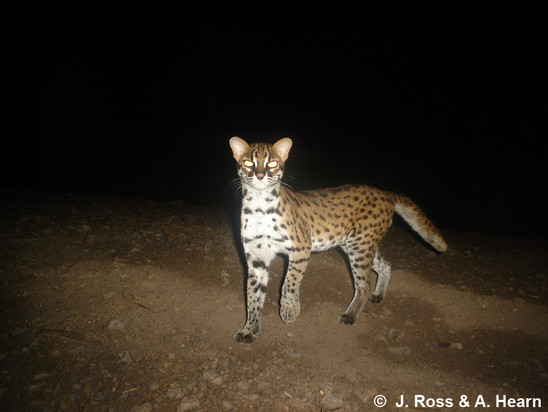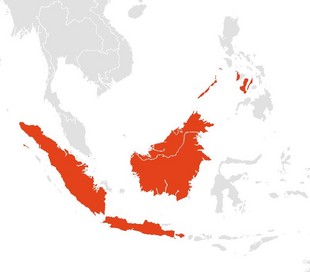Sunda leopard cat
Prionailurus javanensis
IUCN Red List: NA (Prionailurus bengalensis (including Prionailurus javanensis) was assessed as Least concern before the split into two species)
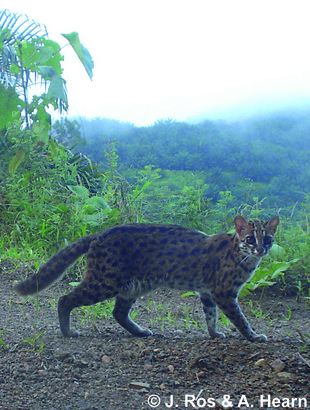
| Weight: | 1.6-8 kg |
| Body length: | 45-65 cm |
| Tail length: | 20-30 cm |
| Longevity: | up to 13 years |
| Litter size: | 2-3 cubs |
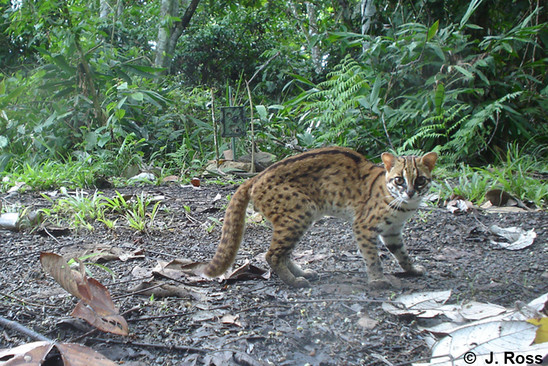
Description
The leopard cat belongs to the genus Prionailurus. On the basis of recent molecular studies, clear morphological differences, possible sympatry between two forms and biogeographic separation, the species was split into two species: the Mainland leopard cat (Prionailurus bengalensis) inhabiting Mainland Asia from Pakistan to South-east Asia, China and the Russian Far East as well as Tsushima Island and Iriomote Island (Japan), and the Sunda leopard cat (Prionailurus javanensis) occurring on Java, Bali, Borneo, Sumatra, Palawan, Negros, Cebu, Panay, Philippines and possibly Malay Peninsula.
A recent phylogeographical study has recognised two subspecies of the Sunda leopard cat:
- Prionailurus javanensis javanensis on Java and Bali, and
- Prionailurus javanensis sumatranus on Sumatra, Borneo and the Philippines.
Previously several subspecies of the Sunda leopard cat have been described: P. b. borneoensis on Borneo, P. b. heaneyi on Palawan island (Philippines), P. b. javenensis on Java and Bali, P. b. rabori on Negros, Cebu and Panay islands (Philippines) and P. b. sumatranus occurring on Sumatra and the offshore island of Tebingtinggi.
The leopard cat looks like a miniature, long-legged and slenderer version of a leopard. It has a round head, a short narrow muzzle and big rounded ears. Its fur is ochre or yellowish-brown with white underparts. The size and shape of the black markings covering the body and limbs are highly variable; the spots sometimes form lines along the neck and back. Often there is one stripe running along the length of the body. The tail is about half as long as the body, spotted and sometimes bears a few rings near the black tip. The ears have black backs with a white central spot and the face is marked with two dark stripes on the forehead. The cat has two narrow black cheek stripes enclosing a white spot. The irises are deep, golden brown to grey. Males are larger than females.
Language/Country | Name |
|---|---|
English | bengal cat |
French | chat léopard du Bengale |
German | Bengalkatze |
Indonesia | kucing batu, kucing congkok |
Malaysia | kucing batu, rimau akar |
Phillippines | maral, tamaral |
Spanish | gato bengali, gato de Bangala |
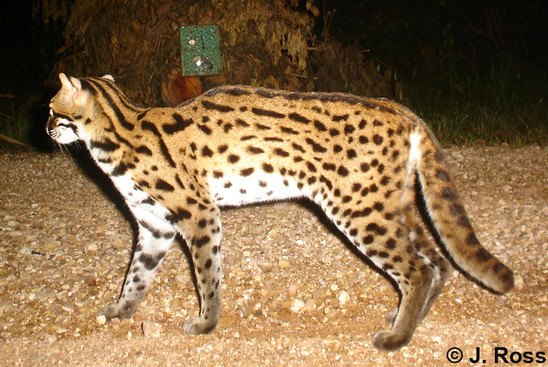
Status and Distribution
The leopard cat is classified as Least Concern by the IUCN Red List. However, this assessment was performed before the recognition of the Sunda leopard cat as a distinct species. Its population status and trends are unknown, but it appears to be relatively common and widespread with stable populations in many areas as indicated by relatively frequent detections during camera trap studies in different habitats, including disturbed areas, throughout its range. However, island populations are vulnerable. The former subspecies P. bengalensis rabori occurring on the Philippine islands is listed as Vulnerable by the IUCN Red List and may have been eliminated from most of its former range on other islands. The National List of Threatened Fauna of the Philippines lists the Sunda leopard cat as Vulnerable.
The density of the leopard cat in Sabah, Malaysian Borneo, has been estimated, using capture-recapture data from camera traps, as 9.6/100 km² in the sustainably managed Deramakot Forest Reserve, and as 12.4/100 km² and 16.5/100 km² in the more disturbed Tangkulap Pinangah and Segaliud Lokan Forest Reserves, respectively.
The Sunda leopard cat occurs on the islands of Sumatra, Java, and Borneo and the Philippine islands of Palawan, Panay, Negros, Cebu and possibly also Masbate. The leopard cat is the only wild cat species which is native to the Philippines.
Habitat
The leopard cat occurs in a variety of habitats. It has been found e.g. in pristine tropical forests, forest mosaics, swamp forest and scrub habitats, but also in selectively logged dipterocarp forest, and in oil palm plantations. A radio-collared male and a radio-collared female on Palawan Island, Philippines, primarily used forests, followed by mixed brushlands. Coconut plantation and built-up areas were also used, but only very rarely. A habitat suitability analysis of Borneo predicted that the large majority of the island offers suitable habitat. Suitable habitat included forested areas, oil palm and rubber plantations, whereas swamp areas were considered to be only marginally suitable. Unsuitable areas included higher elevation areas. In a telemetry study in Sabah, Malaysian Borneo, oil palm plantations were actually used more frequently than could be expected from their availability. In other words, they were selected for, whereas secondary forest fragments were selected against. A reason for this selection might be the relatively higher abundance in oil palm plantations of their primary prey species in this study – Whitehead’s rat. Moreover, hunting success might be higher in oil palm plantations due to the relatively open understorey, which offers fewer holes and crevices in tangled vegetation for prey to hide in, and at the same time possibly an increased advantage for a hunter relying on sight. Although secondary forest fragments within plantations were selected against, they might still be a crucial element to the cat’s survival in this landscape as they offer thick cover for resting and possibly breeding. Within oil palm plantations on Sumatra, leopard cats were more often detected by camera traps in areas where the understory was allowed to grow without the application of herbicides. Various camera trap studies showed differing results: Some studies in Malaysian and Indonesian Borneo found Sunda leopard cats only within oil palm plantations and rehabilitated or disturbed forest, but not in intact or native forest, and others only found them in primary but not in logged forests. On Sumatra, transect surveys resulted in a higher number of Sunda leopard cat tracks being found in forest and scrub habitats than in oil palm plantations. However, the number of direct sightings was highest in oil palm plantations, followed by scrub and by forest habitats. In some areas, leopard cats might also be profiting from strict protection within oil palm plantations as they are sometimes regarded as pest control agent against crop damages caused by rats.
On Negros, Philippines, Sunda leopard cats were found to use sugarcane fields throughout the year, including during the harvest season. There are also regular observations of kittens being found in sugarcane fields.
A habitat suitability model for the island of Java, Indonesia, has shown that only about 15% of non-protected areas consist of suitable habitat for the Sunda leopard cat. Nevertheless, this is twice as much as the total surface of suitable habitat within protected areas.
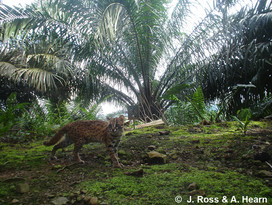
- Leopard cat in palm oil plantation.
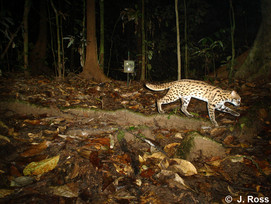
- Leopard cat in primary forest.
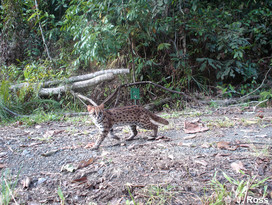
- Leopard cat on a logging road.
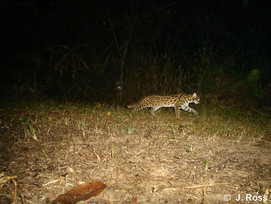
- Leopard cat in Tabin Wildlife Reserve, Malaysia.
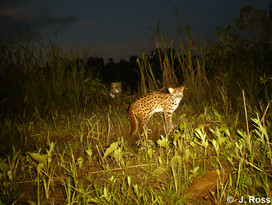
- Leopard cat passing through palm oil plantation.
Ecology and Behaviour
The leopard cat is a solitary species, but has been observed in pairs or with dependent young. It is mainly described as nocturnal and crepuscular[RB1] . However, the leopard cat can also be active during the day with males showing more diurnal activity than females. In Sabah, Malaysian Borneo, the mean home range size of Sunda leopard cats was 3.5 km² for males, and 2.1 km² for females. On Palawan Island, Philippines, the home range of one male was estimated at 6.3 km² and that of one female at 3.9 km². The leopard cat tends to use larger home ranges during the wet season than the dry season. The species uses forests and understory for resting and breeding. It is an adept climber and has been spotted resting in trees. The leopard cat is also a good swimmer and has successfully colonized offshore islands throughout its range. It hunts on the ground and in trees and it has been kept by humans as a rodent control agent in some areas.
In the tropics, breeding can occur year-round. Gestation lasts for 56-70 days. The leopard cat is usually sexually mature at around 18 months old, but sometimes as young as eight months.
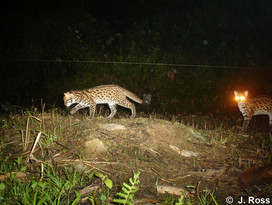
- Leopard cat with kitten.
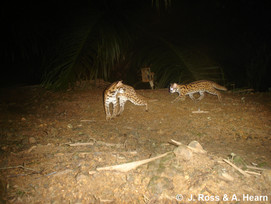
- Leopard cat with kitten.
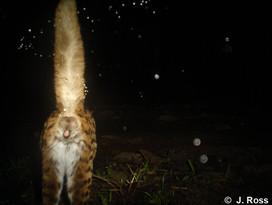
- Leopard cat scent marking.
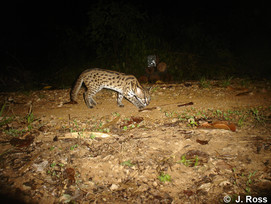
- Leopard cat sniffing on the ground.
Prey
The leopard cat’s main prey are rodents such as rats and mice. Its diet also includes young ungulates, hares, birds, reptiles, amphibians, insects, eels and fish, although the relative importance of each prey species varies across its range. It occasionally takes carrion and poultry.
In studies on Java, murids dominated the diet, but the leopard cat also preyed on lizards, amphibians, birds and insects. Likewise in Sabah, Malaysian Borneo, leopard cats were found to consume mostly murids with Whitehead’s rat (Maxomys whiteheadi) as the most frequent prey species followed by the dark-tailed tree rat (Niviventer cremoriventer). On Palawan Island, Philippines, the fecal samples of three individuals showed mostly the remains of various murids as well as a tree squirrel, treeshrew and an unidentified bird. On a sugarcane farm on Negros, Philippines, the Sunda leopard cats mainly preyed on non-native rats (which are regarded as pest species), and rarely on mice, amphibians, reptiles and birds.
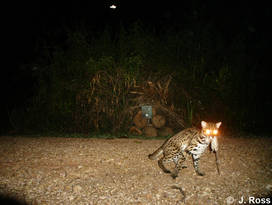
- Leopard cat with its prey.
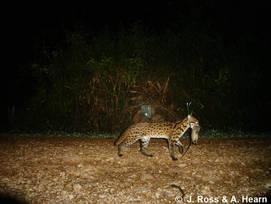
- Leopard cat carrying a rodent.
Main Threats
The leopard cat seems to be more tolerant to deforestation and habitat alteration than other Asian felids, with the exception of the jungle cat. The leopard cat uses also degraded forest and modified habitats such as oil palm plantations. However, the species is not invulnerable and in some parts of its range, populations are declining due to habitat loss or hunting. In disturbed regions and areas with greater human activity, it has a higher mortality than in protected areas where survival rates are higher. Leopard cat populations are especially vulnerable on small islands; for instance, the populations on the Philippines are seriously threatened. The former subspecies P. b. rabori on the Philippines was reported to have already lost at least 95% of its former range and to survive only in a few remaining pockets of forest on the islands of Panay, Negros and Cebu. None of these remaining forest areas are currently protected.
On Java and Bali, there are animal markets comprising between less than 20 and up to over 200 stalls or shops. Due to a lack of law enforcement, protected species are openly displayed and sold on these markets. The Sunda leopard cat is mainly offered as an ‘exotic’ or ‘novelty’ pet. However, the number of cats on offer appears to be decreasing. In the mid-1990s, almost 2 cats were found per survey. This number dropped to slightly less than 0.5 cats per survey in the 2010s. They were also found in fewer markets. For Java, a total trade amount of 600 Sunda leopard cats per year is estimated. Meanwhile, the prices for which the cats are being sold have risen. It appears that all of the individuals on offer are sourced from the wild – mostly juveniles collected as litters – with apparently no animals stemming from outside of the respective island and with no captive breeding for the market.
However, the Sunda leopard cat seems to be of minor importance to the traders. Most stalls offer at the same time also high-end breeds of domestic cats, which are much better taken care of and generate much more revenue for the traders. There is no indication on these markets, that the Sunda leopard cat is intended for the international / tourist market. The leopard cat is considered a poultry pest in many areas and killed in retribution. Snares set for other target species are also a serious problem.
Conservation Effort and Protection Status
The leopard cat is included on CITES Appendix II. The leopard cat is protected across part of its range. Hunting is prohibited in Indonesia, Malaysia, and on the Philippines. There is no legal protection outside protected areas in Brunei. It is found in numerous protected areas.
Further research is needed to determine both the taxonomic and conservation status of the leopard cat. Although it seems to be tolerant to different types and levels of habitat disturbance, the degree of this tolerance is currently unknown and must be researched.
